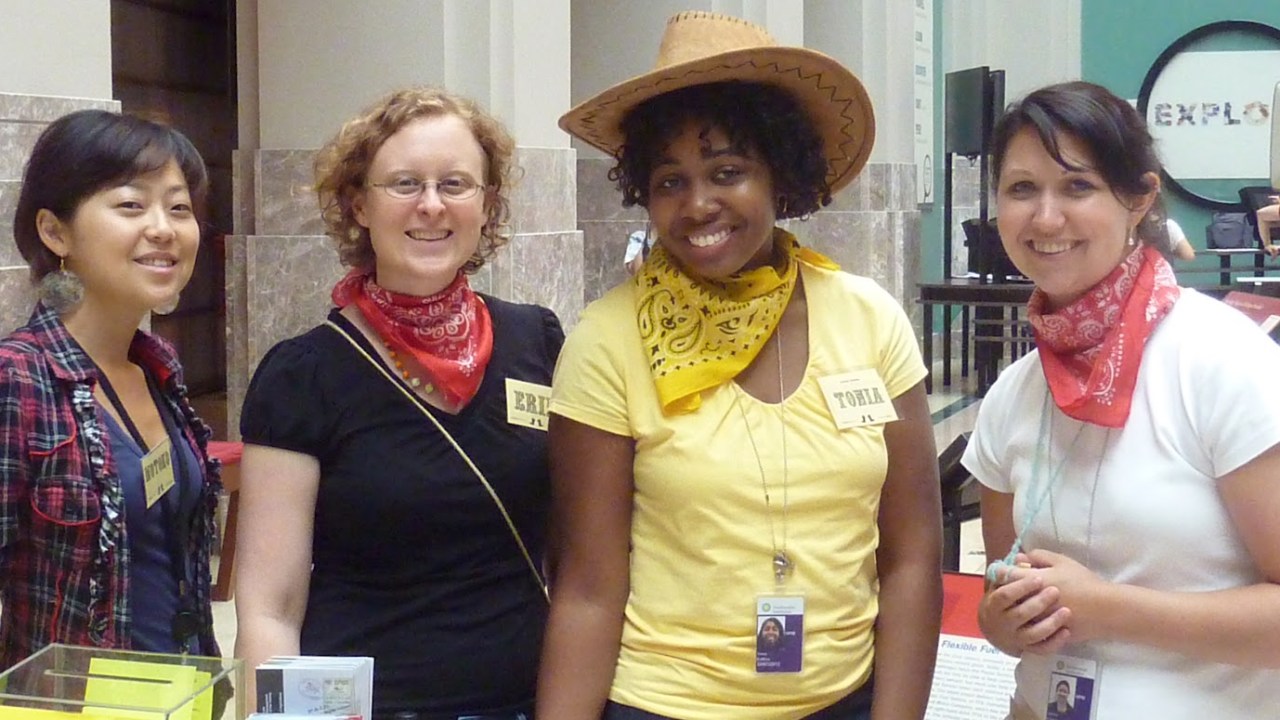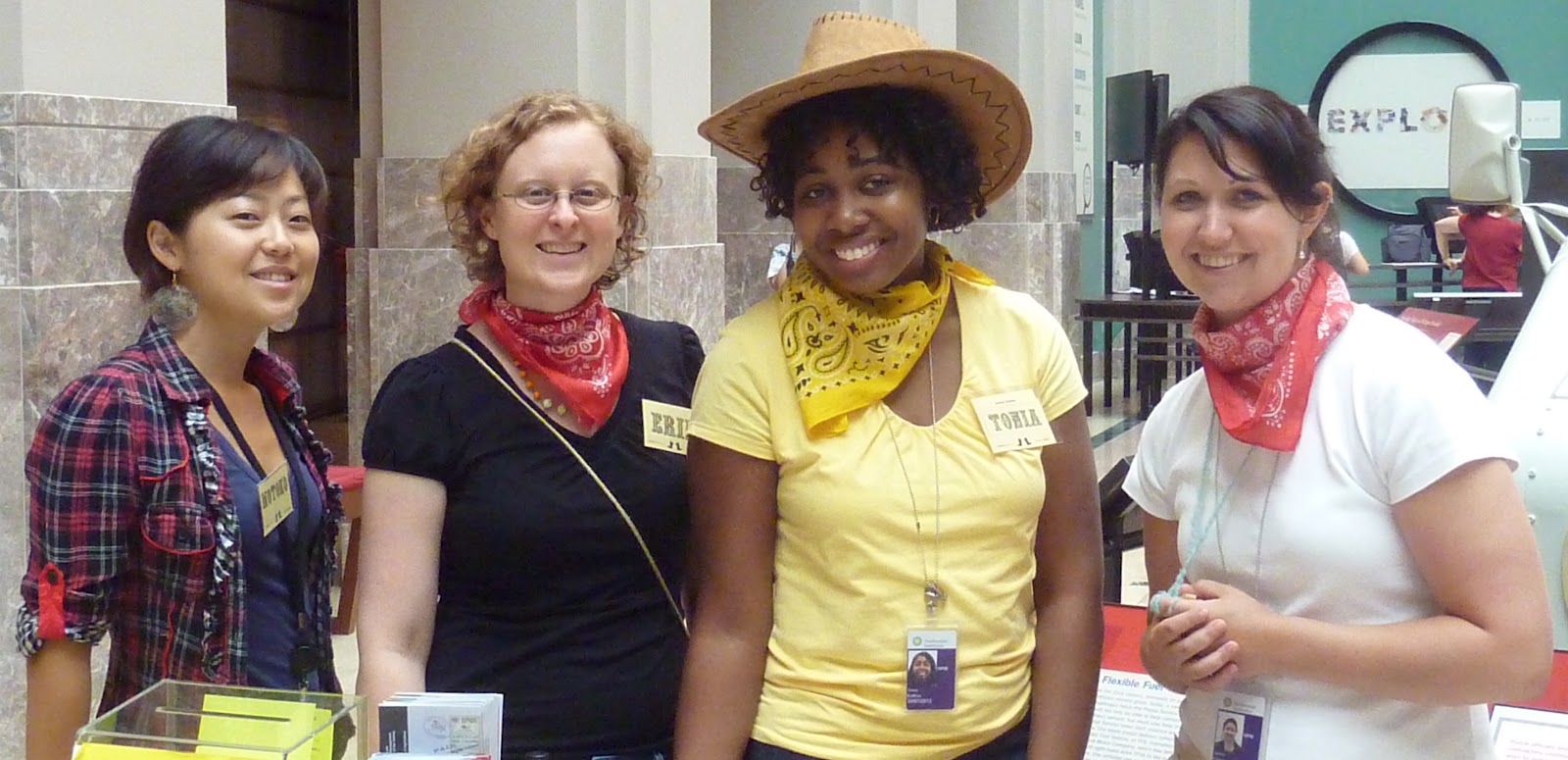
Erin Blasco does public programs and social media at the Smithsonian’s National Postal Museum. You can always say hi to her on Twitter at @erinblasco. Today she shares a new initiative they’ve begun to recognize their volunteers.
If you work with museum volunteers, you know they often go above and beyond their basic duties. At the Postal Museum, we’re lucky to have volunteers who conduct research projects, attend every museum lecture and get sore hands from cutting out puppet pieces in addition to their basic duties. We also have volunteers who frequently impress us with small scale actions like our volunteer who makes a themed pair of earrings for every public program she participates in, showing our visitors just how dedicated our volunteers are and, in a quirky way, reinforcing the program theme.
These volunteers don’t go above and beyond because they’ll get a t-shirt or tote at the end of the year; they’re motivated, lifelong learners enthusiastic about doing more because it’s intrinsically rewarding and helpful to a museum they respect.
 |
| Wearing silly costumes for Pony Express Family Day is above and beyond in our book. |
Recently we combined disparate volunteer teams into one collaboratively managed group, and noticed that the volunteer community at large was not always benefiting from these individual achievements. The museum appreciated volunteer initiative and individual volunteers were certainly happy, but we wanted to spread the benefits around so that more volunteers could capitalize on Ida Marie’s research on mail dogsleds, Hilarie’s knowledge about the Postcrossing community and Robin’s passion for Eastern European stamps. If members of our volunteer community could draw from each other’s knowledge, skills and passions, we’d eventually offer our visitors the opportunity to interact with more enthusiastic and more accomplished volunteers. Thinking bigger, these savvy, capable volunteers might be better able to share their knowledge and skills with the wider community, leading trainings at community centers or representing the Postal Museum when they visit museums outside D.C.
Seeking a platform to spread the awesome-ness
We chose to help our volunteers identify new topics to explore and ways to learn, recognize them for their achievements and share them across the museum community with digital badging. We first discovered the open badging movement from LearningTimes, who directed us to Mozilla’s Open Badges project. Outside the classroom learning is enriching and useful but it’s often hard to get credit for what you learn. While you might spend time with a mentor learning to operate a 3D printer or cook authentic paella, you can’t receive a certificate or diploma (and if you did, it might not be widely accepted).
Open badging addresses this by providing an open, free platform where anyone can “issue, earn and display badges across the Web.” Once you earn a badge, you display it in a “badge backpack” as well as on your Facebook page, blog or resume. This showcases your knowledge and experience in a way that might impact your career, access to educational opportunities and who knows what else.
Adapting to badging at the Postal Museum
The Postal Museum’s new badging program is so far not a true “open” badging platform—volunteers can’t snazzily display their badges online—but we’d like to include this feature in the future. For now, they get public recognition of completed badges on a poster outside the volunteer lounge and soon this system will be supported by the online volunteer management tool the Smithsonian is adopting.
 |
| School and tours coordinator Motoko Hioki shows off our (currently low tech) badge poster. |
- Spark a hunger for learning, provide a menu of learning opportunities: Expose volunteers to the skills they can master, knowledge they can share and experiences they can have. Make it easy for them to identify museum-related pursuits enriching to them, helpful to the museum and that can improve the volunteer community.
- Identify and reward expertise: Give volunteers credit for their achievement. It’s not a tote bag or mug, it’s public recognition that a volunteer achieved something awesome and is therefore a resource to the museum community. The badge is also a great way for a volunteer to identify a mentor able to help earn a new badge. Many of the badges we’ve created require staff sign-off, but some can be awarded by one volunteer to another.
- Create a networked community of learners: Strengthen skills, increase knowledge, heighten engagement and create a community of learning across our volunteer teams. Re-orient the direction(s) of volunteers’ enthusiasm so that they share their achievements with the entire Postal Museum community, not just their direct staff supervisors.
Looking forward:
- Museums issue badges to volunteers deputizing them to represent the museum at community events and beyond in ways supporting our mission. We already have volunteers authorized to help Boy Scouts earn their Stamp Collecting Merit Badge. Why not send them into the community to teach Art Appreciation 101 or citizen science projects like identifying invasive species? This brings the museum to interested groups of learners without a significant increase in staff workload and a net benefit to the community.
- Museums issue badges to the general public. The social media team here at the Postal Museum is well aware of the Letter Writers Alliance, a club of dues-paying members who adore correspondence and earn access to exclusive club merch as well as club-only blog posts. The Postal Museum could offer badges in stamp collecting, correspondence, and even paper preservation, and then issue badges to help participants showcase their achievement.









Thanks Erin, a colleague informed me of your article when I told her about my own plans to issue badges for our volunteers at Minnesota Children's Museum. For us, the goal is to use them as a way to recognize volunteers for their service and provide a reason for them to engage with us online to a greater extent.
The concept of using badges to track and recognize volunteers for skill and experience development is really interesting. Hopefully we'll get there some day relatively soon. I'll be looking forward to the first time I see a badge attached to someone's profile coming from a volunteer program other than my own.